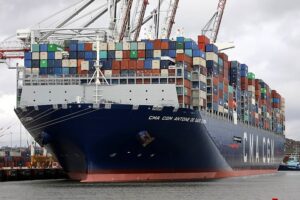The shipping container that has been the building block of global trade growth is turning into the latest source of frustration for importers and exporters coping with world-wide supply-chain disruptions.

The steel boxes are harder than ever to find as surging demand to restock inventories and a series of shipping disruptions has left many thousands of containers stranded at sea on ships anchored near jammed-up ports. Still more are stacking up at inland freight hubs in the U.S., Europe and Asia as companies struggle to cope with the cargo flows that at times have overwhelmed their operations.
The result is what Tim Boyle, chief executive of Columbia Sportswear Co., on a recent earnings conference call said is a “container dislocation” that has contributed to skyrocketing costs and complicated efforts to meet resurgent consumer demand.
Containers are essential equipment for global trade, providing the ability to efficiently handle large volumes of consumer goods, apparel, manufacturing parts and other materials across today’s long supply chains.
The boxes are in short supply even though much of the world seems awash in shipping containers and as production of the boxes is expected to hit record levels this year.
Container factories, concentrated almost solely in China, are expected to produce a record 5.4 million 20-foot-equivalent units, or TEUs, of the steel boxes this year, according to Drewry Shipping Consultants Ltd. The production has grown rapidly since 2.8 million TEUs were produced in 2019, part of a yearslong decline in orders amid economic uncertainty and slowing global trade growth.
John Fossey, head of container equipment and leasing research for London-based Drewry, said that in principle there are more than enough containers to handle global trading volumes. In practice, he said, availability in several parts of the world has become incredibly tight because large volumes of containers are stuck in the wrong place.
Mr. Fossey said the pullback in production in recent years may have contributed to today’s shortages, but the disruption triggered by the pandemic has been the main factor hampering availability.
Lars Jensen of Denmark-based shipping consultants Vespucci Maritime, traces the beginning of the container shortage to the early months of the pandemic, in the spring of 2020, when consumer demand slumped and shipping lines canceled many of their routes between Asia and North America. As consumer demand snapped back during the summer of 2020, thousands of empty containers were stuck in the U.S. and exporters in China faced long waits for boxes to ship their goods.
Events such as a grounded container ship’s blockage of the Suez Canal in March, the shutdown of a key port in southern China in May and June that left some 350,000 containers idle and big backups at ports in the U.S. and Europe have added to the strains.
Now, some U.S. exporters say shipping lines are refusing to send boxes inland to pick up their cargo because they are trying to get empty containers back to factories in Asia as quickly as possible to take advantage of historically high shipping prices for exports from the continent.
Peter Friedmann, executive director of the Agriculture Transportation Coalition, said a survey of members in the fall showed that 22% of sales are lost because they can’t get cargo overseas.
For the loaded containers that are sent inland, congestion on rail networks and a shortage of truck chassis, drivers and warehouse workers has led to big backups at cargo facilities as companies struggle to unpack the boxes and get them back into circulation.
Freight railroads Union Pacific Corp. and BNSF Railway recently restricted transport of shipping containers from the West Coast ports to Chicago to give them time to clear the stacks of containers that had grown at the Midwestern shipping hub.
Truckload carrier Schneider National Inc. said the “average unload dwell time” for its customers using containers was up 70% in the second quarter over the same period in 2019 because of a shortage of workers to handle the boxes. The company has added about 1,000 containers to its network and Chief Executive Mark Rourke said in an earnings conference call July 29 that it would “bend our network to give priority to those shippers and consignees who most efficiently and effectively” unload and return containers and truck chassis.
The strains on equipment availability are drawing the attention of regulators. Carl Bentzel, a member of the Federal Maritime Commission, recently raised concerns about the reliance by U.S. exporters on containers and truck chassis that are made in China.
Read Also: GLOBAL MARINE ACCIDENTS
Congestion and delays have increased the time it takes a container to get from Beijing to Chicago to more than 70 days from about 30 days, Mr. Bentzel said.
There doesn’t appear to be much that regulators can do in the near term to make more containers available, however, and industry executives and experts say the strains on supply chains are likely to last through the end of the year, providing little hope of relief for shippers.
Ken O’Brien, president of Gemini Shippers Group, a New York City-based cooperative that represents more than 250 companies who buy space on ships, said it is strange there isn’t a pile of containers waiting to be picked from. “You just always thought they were there, and now it’s very much a hand to mouth operation,” he said.
*Source: Wall Street Journal
Kindly like us on Facebook
















Discussion about this post